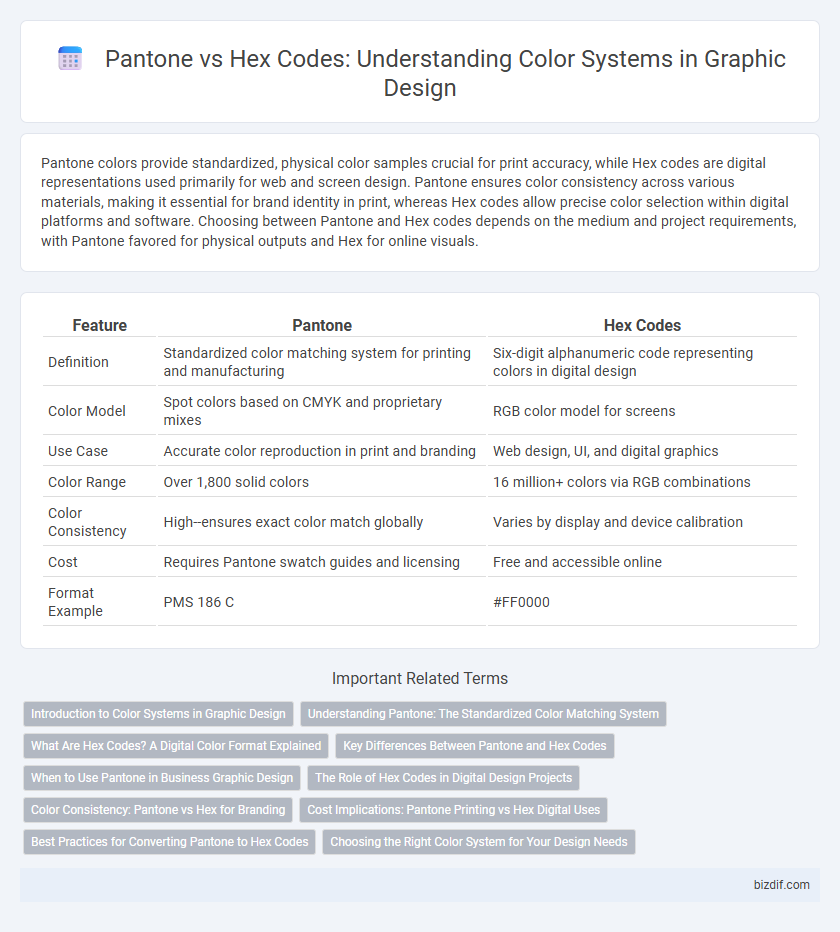Pantone colors provide standardized, physical color samples crucial for print accuracy, while Hex codes are digital representations used primarily for web and screen design. Pantone ensures color consistency across various materials, making it essential for brand identity in print, whereas Hex codes allow precise color selection within digital platforms and software. Choosing between Pantone and Hex codes depends on the medium and project requirements, with Pantone favored for physical outputs and Hex for online visuals.
Table of Comparison
| Feature | Pantone | Hex Codes |
|---|---|---|
| Definition | Standardized color matching system for printing and manufacturing | Six-digit alphanumeric code representing colors in digital design |
| Color Model | Spot colors based on CMYK and proprietary mixes | RGB color model for screens |
| Use Case | Accurate color reproduction in print and branding | Web design, UI, and digital graphics |
| Color Range | Over 1,800 solid colors | 16 million+ colors via RGB combinations |
| Color Consistency | High--ensures exact color match globally | Varies by display and device calibration |
| Cost | Requires Pantone swatch guides and licensing | Free and accessible online |
| Format Example | PMS 186 C | #FF0000 |
Introduction to Color Systems in Graphic Design
Pantone and Hex codes represent two distinct color systems essential in graphic design for consistent color communication across print and digital media. Pantone operates through a standardized color matching system used primarily in print, ensuring precise color reproduction with unique codes for each hue. Hex codes, on the other hand, define colors in web design using six-digit hexadecimal values that correspond to RGB color combinations displayed on digital screens.
Understanding Pantone: The Standardized Color Matching System
Pantone is a standardized color matching system widely used in graphic design to ensure consistent color reproduction across different materials and processes. Each Pantone color is assigned a unique code, allowing designers and manufacturers to communicate exact shades without ambiguity. Unlike Hex codes used for digital displays, Pantone colors are formulated based on pigment mixtures, providing precise color matching for print and physical products.
What Are Hex Codes? A Digital Color Format Explained
Hex codes are six-digit alphanumeric codes representing colors in digital design, defined by the RGB (red, green, blue) color model used in web and screen displays. Each pair of characters in a hex code signifies the intensity of red, green, or blue components, allowing precise color specification in HTML, CSS, and other digital formats. Unlike Pantone colors, which are standardized physical ink colors for printing, hex codes enable consistent color reproduction across digital platforms and devices.
Key Differences Between Pantone and Hex Codes
Pantone colors are standardized spot colors used primarily in print to ensure color accuracy, while Hex codes define colors for digital screens using a six-digit alphanumeric system representing RGB values. Pantone offers consistency across physical media with specific ink formulations, whereas Hex codes vary depending on device display capabilities and settings. The key difference lies in Pantone's focus on physical color matching versus Hex codes' role in digital color representation.
When to Use Pantone in Business Graphic Design
Pantone colors ensure precise brand color consistency across various print materials, making them essential for logo design and corporate identity projects in business graphic design. Hex codes are ideal for digital applications due to their compatibility with web and screen displays, but they can vary when printed. Businesses seeking exact color matching for packaging, merchandise, or official documents rely on Pantone for reliable, standardized color reproduction.
The Role of Hex Codes in Digital Design Projects
Hex codes play a critical role in digital design projects by providing precise color representation using six-digit alphanumeric values that define red, green, and blue (RGB) components. Unlike Pantone colors that rely on physical ink formulations for print accuracy, hex codes ensure consistent display across various digital screens and devices. This digital specificity enables designers to maintain color integrity in web design, user interfaces, and online branding efforts.
Color Consistency: Pantone vs Hex for Branding
Pantone colors provide precise, standardized color formulations ensuring consistent brand color reproduction across various print materials worldwide, minimizing color variations caused by different printers or substrates. Hex codes represent colors on digital screens using RGB values, but can vary significantly across devices due to differences in screen calibration and lighting conditions, potentially compromising brand color uniformity online. Brands relying on Pantone for print materials and hex codes for digital platforms must implement strict color management practices to maintain visual consistency across all brand touchpoints.
Cost Implications: Pantone Printing vs Hex Digital Uses
Pantone printing incurs higher costs due to specialized ink formulations and limited color runs, making it ideal for consistent branding in physical materials. Hex codes streamline digital design by offering infinite color variations at virtually no extra cost, enhancing flexibility for web and screen use. Budget-conscious projects often favor Hex codes for cost-efficiency, while Pantone remains preferred for premium print quality and color accuracy.
Best Practices for Converting Pantone to Hex Codes
Converting Pantone colors to hex codes requires precise color matching to maintain brand consistency across digital platforms. Use reputable color conversion tools or Pantone's official color guides to ensure accuracy, as direct conversions can vary due to different color gamuts. Always test converted hex codes on various devices and screens to verify visual fidelity before finalizing design assets.
Choosing the Right Color System for Your Design Needs
Pantone colors offer precise color matching with standardized ink formulations, making them ideal for print projects requiring exact color reproduction. Hex codes, used primarily for digital design, provide easy integration with web and screen applications, allowing designers to specify colors via six-digit alphanumeric codes. Selecting the right color system depends on the medium and color accuracy needed--Pantone for physical printing consistency and Hex codes for versatile digital displays.
Pantone vs Hex Codes Infographic

 bizdif.com
bizdif.com